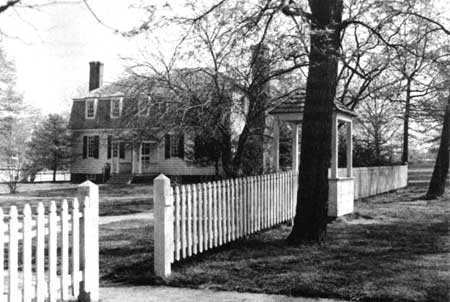|
YORKTOWN National Battlefield |
 |
Siege of Yorktown
(continued)

The restored Moore House where the Articles of
Capitulation for the British Army were drafted.
NEGOTIATION AND SURRENDER. When the British flag of truce was seen by the allied officers on the morning of the 17th, the incessant and devastating artillery fire ceased. It had been continuous since October 9, except for short intervals when batteries were being shifted or a flag of truce was passing between the lines. Cornwallis' letter, which was transmitted immediately to Washington, read: "I propose a cessation of hostilities for twenty four hours, and that two officers may be appointed by each side, to meet at Mr. Moore's house, to settle terms for the surrender of the posts of York and Gloucester."
Washington replied that he would grant the British general 2 hours in which to submit definite terms. At about 4:30 p. m., Cornwallis replied. Washington found his proposals satisfactory in part, and in his reply stated that the British could expect that: "The same Honors will be granted to the Surrendering Army as were granted [by the British] to the [American] Garrison of Charles Town [in 1780]."
Arrangements were concluded for the differences of opinion to be ironed out during a meeting of commissioners at the home of Augustine Moore in the rear of the first siege line. The commissioners (Lt. Col. Thomas Dundas and Maj. Alexander Ross, representing the British; the Viscount de Noailles, the French; and Lt. Col. John Laurens, the Americans) met there on October 18 and, after a heated and prolonged session, drafted the Articles of Capitulation. On the morning of the 19th, Washington reviewed the draft and, after some modification, had the articles transcribed. The document was then sent to Cornwallis for his signature, with a deadline of 11 a. m. Cornwallis duly signed, as did Capt. Thomas Symonds, representing the British naval units in the York. The allied commanders, Washington and Rochambeau, appear to have signed the document in captured British Redoubt No. 10. The Count de Barras, designated to act in place of the Count de Grasse for the French fleet, also signed for the allies.
The articles provided that the troops, seamen, and marines should surrender as prisoners of war. Officers were to retain their sidearms and private papers and property. The soldiers were to be kept in prison camps in Virginia, Maryland, and Pennsylvania. Cornwallis and certain of the officers were to be allowed freedom on parole and the sloop Bonetta was to be made available for the British commander to carry dispatches to Sir Henry Clinton, after which she was to be surrendered.
At noon on October 19, two redoubts southeast of Yorktown were occupied by allied troops—one by an American unit and the other by a French detachment. At 2 p. m., the British Army, clad in a new issue of uniforms and led by Brigadier General O'Hara (Cornwallis was ill), marched out from Yorktown along the York-Hampton Road to the tune of an old British march titled "The World Turned Upside Down."
In the vicinity of the present national cemetery, O'Hara reached the head of the allied column. It appears that he sought first the Count de Rochambeau, but was referred to Washington. Washington, in turn, sent him to Major General Lincoln, who accepted his sword—the token of defeat and surrender—and then returned it. Following this, the British Army marched down Surrender Road between columns of allied troops, Americans on the British left (east) and French on the British right (west), to Surrender Field where the formal surrender was effected. ". . . we came directly onto a level field or large meadow, where . . . we . . . marched one regiment after another, stacked muskets and lay down all arms . . .", wrote one of the British soldiers. Thus, the siege of Yorktown ended, the climax of the Revolution had passed, and America could look forward toward a free and independent status. A new nation had been born!
THE SEQUEL. After the surrender, the British units returned to Yorktown. After 2 days' rest, the rank and file and junior officers were marched off to prison camps in western Virginia and Maryland. Both Washington and Rochambeau invited their distinguished prisoners to their tables, and for several days camp dinners were the fashion, the English attending as guests. The American units of the Allied armies took up the return march to the Hudson about November 1. The French, for the most part, remained on the peninsula until spring and then left for Rhode Island, having wintered in Yorktown, Williamsburg, Hampton, and other nearby points. De Grasse sailed for the West Indies shortly after the siege was over. The British expedition, which was to relieve Cornwallis, reached Virginia waters late in October, too late to be of any use.

|
|
Last Modified: Mon, Dec 2 2002 10:00:00 am PDT |


